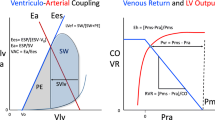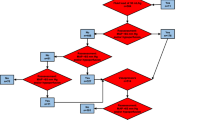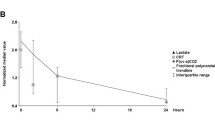Abstract
Objective
To identify early prognostic markers of septic shock among catheterization-derived hemodynamic and metabolic data.
Design
Prospective cohort study.
Setting
A medical intensive care unit in a university hospital.
Patients
Thirty-two consecutive patients with septic shock, separated into two groups according to shortterm (10-day) evolution: 18 acute survivors and 14 fatalities.
Measurements
Usual hemodynamic and metabolic variables were measured at the onset of shock, i.e. when the catheter was inserted (T0), and 24 h later (T24). The values collected for each group at T0 and T24 and their 24-h changes were compared.
Results
On admission, no difference was found between acute survivors and eventual fatalities. After 24 h, fatalities presented with significantly lower mean arterial pressure (p<0.01), left ventricular stroke work index (P<0.05) and higher lactate levels (p<0.01) than acute survivors. Moreover, the 24-h changes of lactate and blood pressure were also of prognostic value (p<0.05). Oxygen delivery and oxygen consumption did not differ statistically between the two groups. At T24, a mean arterial pressure of less than 85 mmHg and a lactate level equal to or greater than 3.5 mmol/l were independently associated with poor survival (37.5% and 30.7%, respectively). Day 10 survival was only 12.5% when both criteria were present at T24.
Conclusions
Changes in mean arterial pressure and arterial blood lactate within the first 24 h of treatment are strong prognostic indicators of short-term survival in patients with septic shock. After 24 h of treatment, maintenance of a mean blood pressure equal to or greater than 85 mmHg correlates with survival at day 10. Data suggest that early reductions in both cardiac function and vascular tone play a determining role in the hypotension observed in fatalities. Persistence of hyperlactatemia in hypotensive patients bodes particularly ill. Blood pressure and lactate level are simple bedside parameters that can enable the clinician to identify patients with a high risk of mortality.
Similar content being viewed by others
References
Parker MM (1990), Cardiac dysfunction in human septic shock. In: Parillo JE, Septic shock in humans: advances in the understanding of pathogenesis, cardiovascular dysfunction and therapy. Ann Intern Med 115:227–242
Thijs LG, Groeneveld ABJ (1987), The circulatory defect of septic shock. In: Vincent JL, Thijs LG (eds) Update in intensive care and emergency medicine. Septic shock. Springer, Berlin Heidelberg New York, pp 161–178
Pinsky MR (1990) Assessment of adequacy of oxygen transport in the critically ill. Appl Cardiopulm Pathophysiol 3:271–278
Parker MM, Shelhamer JH, Natanson C, Alling DW, Parillo JE (1987) Serial cardiovascular variables in survivors and nonsurvivors of human septic shock: heart rate as an early predictor of prognosis. Crit Care Med 15:923–929
Groeneveld ABJ, Bronsveld W, Thijs, LG (1986) Hemodynamic determinants of mortality in human septic shock. Surgery 99:140–153
Hankeln KB, Senker R, Schwarten JU, Beez MG, Engel HJ, Laniewsky P (1987) Evaluation of prognostic indices based on hemodynamic and oxygen transport variables in shock patients with adult respiratory distress syndrome. Crit Care Med 15:1–7
Bihari D, Smithies M, Grimson A, Tinker J (1987) The effects of vasodilation with prostacycline on oxygen delivery and uptake in critically ill patients. N Engl J Med 317:307–303
LeGall JR, Loirat P, Alperovitch A (1983) Simplified acute physiologic score for intensive care patients. Lancet II:741–743
LeGall JR (1987) Prognosis of septic shock. In: Vincent JL, Thijs LG (eds) Update in intensive care and emergency medicine. Septic shock. Springer, Berlin Heidelberg New York, pp 283–288
Dhainaut JF, Huyghebaert MF, Monsallier JF, Lefevre G, Dall'Ava Santucci J, Brunet F et al (1987) Coronary hemodynamics and myocardial metabolism of lactates, free fatty acids, glucose, and ketones in patients with septic shock. Circulation 75:533–541
D'Orio V, Mendes P, Saad G, Marcelle R (1990) Accuracy in early prediction of prognosis of patients with septic shock by analysis of simples indices: prospective study. Crit Care Med 18: 1339–1345
Tuchschmidt J, Fried J, Swinney R, Sharma OMP (1989) Early hemodynamic correlates of survival in patients with septic shock. Crit Care Med 17:719–723
Vincent JL, Weil MH, Puri V, Carlson RW (1981) Circulatory shock associated with purulent peritonitis. Am J Surg 142:262–270
Groeneveld ABJ, Kester ADM, Nauta JJP, Thijs LG (1987) Relation of arterial blood lactate to oxygen delivery and hemodynamic variables in human shock states. Circ Shock 22:35–53
Vincent JL, Gris P, Coffernils M, Leon M, Pinsky M, Reuse C, Kahn RJ (1992) Myocardial depression characterizes the fatal course of septic shock. Surgery 111:660–667
Mizock BA, Falk JL (1992) Lactic acidosis in critical illness. Crit Care Med 20:80–93
Weil MH, Afifi AA (1970) Experimental and clinical studies on lactate and pyruvate as indicators of the severity of acute circulatory failure (shock). Circulation 41:989–901
Vincent JL, Dufaye P, Berré J, Leeman M, Degaute JP, Kahn RJ (1983) Serial lactate determinations during circulatory shock. Crit Care Med 11:449–451
Azimi G, Vincent JL (1986) Ultimate survival from septic shock. Resuscitation 14:245–253
Bakker J, Coffernils M, Leon M, Gris P, Vincent JL (1991) Blood lactate levels are superior to oxygen-derived variables in predicting outcome in human septic shock. Chest 99:956–962
Falk JL, Rackow EC, Leavy J et al (1985) Delayed lactate clearance in patients surviving circulatory shock. Acute Care 11:212–215
Ronco JJ, Fenwick JC, Wiggs BR, Phang PT, Russel JA, Tweeddale MG (1993) Oxygen consumption in independent of increases in oxygen delivery by dobutamine in septic patients who have normal or increased plasma lactate. Am Rev Respir Dis 147:25–31
Gutierrez G, Bismar H, Dantzker D, Silva N (1992) Comparison of gastric intramucosal pH with measures of oxygen transport and consumption in critically ill patients. Crit Care Med 20: 451–457
Friedman G, Berlot G, Kahn RJ, Vincent JL (1994) Combination of blood lactate levels and pH in severe sepsis. Crit Care Med 22: A112
Intaglietta M (1989) Objectives for the treatment of the microcirculation in ischemia, shock, and reperfusion. In: Vincent JL (ed) Update in intensive care and emergency medicine. Springer, Berlin Heidelberg New York, pp 293–298
Russel JA, Ronco JJ, Lockhat D, Belzberg A, Kiess M, Dodek PM (1990) Oxygen delivery and consumption and ventricular preload are greater in survivors than in nonsurvivors of the adult respiratory distress syndrome. Am Rev Respir Dis 141:659–665
Shoemaker WC, Appel P, Kram H, Waxman K, Lee TS (1988) Prospective trial of supranormal values of survivors as therapeutic goals in high-risk surgical patients. Chest 94:1176–1186
Tuchschmidt J, Fried J, Astiz M, Rackow E (1992) Elevation of cardiac output and oxygen delivery improves outcome in septic shock. Chest 102: 216–220
Edwards JD, Brown GCS, Nightingale P, Slater RM, Faragher EB (1989) Use of survivors cardiorespiratory values as therapeutic goals in septic shock. Crit Care Med 17:1098–1103
Martin C, Eon B, Saux B, Albanese J, Aknin P, Gouin F (1989) Utilisation de la noradrénaline dans le traitement du choc septique. Ann Fr Anesth Réanim 8:19–25
Shoemaker WC, Appel PL, Wakman K, Schwartz S, Chang P (1982) Clinical trial of survivors cardiorespiratory patterns as therapeutic goals in critically ill postoperative patients. Crit Care Med 10:398–303
Hayes MA, Timmins AC, Yan EHS, Palazzo M, Hinds CJ, Watson D (1994) Elevation of systemic oxygen delivery in the treatment of critically ill patients. N Engl J Med 330:1717–1722
Author information
Authors and Affiliations
Rights and permissions
About this article
Cite this article
Gernardin, G., Pradier, C., Tiger, F. et al. Blood pressure and arterial lactate level are early indicators of short-term survival in human septic shock. Intensive Care Med 22, 17–25 (1996). https://doi.org/10.1007/BF01728326
Received:
Accepted:
Issue Date:
DOI: https://doi.org/10.1007/BF01728326




